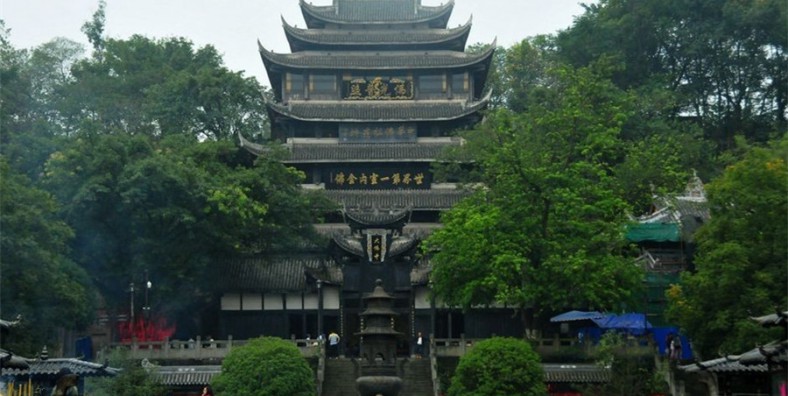
Great Buddha Temple in Tongnan District, Chongqing

Attractions Overview
Located on the northern bank of the Yangtze River in jiangjin district, it was founded in Song Dynasty. It is a temple with the Buddhist statue of Shui Yue Guanyin as the main body. On August 16, 1956, it was announced by the Sichuan Provincial People's Government as the first batch of provincial key cultural relics protection units.
Chinese Name: 潼南大佛寺
English Name: Great Buddha Temple in Tongnan District
Type: Cultural Scenic Area, Chongqing famous spots & Cultural attractions
Best Time: All Year Around
Recommended Visiting Hours: 1-3 hours
Opening Hours:08: 00-17: 00 (January 1-December 31, Monday-Sunday)
Ticket:25 yuan
Location: Located in Shimen Town, Jiangjin City, Chongqing, 50km from Jiangjin City
Why is Great Buddha Temple so Special?
Tongnan Great Budhha Temple is located to the northwest of Tongnan County at the foot of Dingming Mountain. There are four ancient wooden structures within Tongnan Great Buddha Temple: the Great Buddha Pavilion, Guanyin Hall, Yuhuang Hall and Jian Pavilion. The Great Buddha Pavilion is a seven eave, gable and hip roof style building. There is a very solemn looking sitting statue of the Gautama Buddha within the pavilion, which is commonly referred to as the “Eight Zhang Golden Immortal.” On the walls around the sitting statue of the Gautama Buddha, there are inscriptions, poems and stelae from literati of previous dynasties.
Brief Introduction
Shimen Dafo Temple is located on a high cliff near the Yangtze River in Shimen Town, jiangjin district. The statue of Lotus Goddess of Mercy served by the temple owner is the largest of its kind in the country, so it is reputed as “the largest Buddha in the Yangtze River”.
The two inscriptions on the rock wall of Dafosi Temple have become blurred due to the weathering of years. Another monument to rebuild the Great Buddha Temple was erected in the 8th year of Tongzhi in Qing Dynasty (AD 1869) by Du Jialu. The inscription said: “the great Buddhist temple was built in the early dynasty. It is difficult to record the year when it was opened up. Stone stack ladder, has the potential to hook up, eventful abrupt, rise Qiao strange. Seven storeys of pavilions are full of clouds and clouds, and ten zhangs’ walls are thin enough to reflect the sun and the moon. ” The inscription gives a full description of the scenery of the Buddhist temple.
Structure
The Dafosi Temple is built on cliffs with a low topography in the south and a high topography in the north. There is a stone winding path from the cliff to the river to connect with the temple. Inside the Great Buddha Temple is the layout of the Sanhe Court, with wing rooms on the left and right, and the main hall in the middle. It is divided into Songzi Hall, Guanyin Hall and Lei Temple in sequence. The stone sculpture in the temple is a Guanyin statue with a height of 13.5 meters.
Shimen Dafosi Building is a seven-eave mountain wood structure building, which is a typical high-rise building in the Qing Dynasty in China. The ancient temple stands against the mountain and faces the Yangtze River. The seven-eave building is stacked one on top of the other, making it majestic. Dafosi and stone carvings are the crystallization of the wisdom of the ancient working people in Jiangjin. They are of great historical, scientific and artistic value. The Cliff Statue of Shimen Dafosi was built on the edge of the Yangtze River. Apart from its original religious significance, it also had a great significance in suppressing floods, which was also of great significance in studying the water conservancy situation of the Yangtze River at that time.
Value
Dafosi Scenic Area is an important part of Dingming Mountain-Canal Scenic Area, with a huge amount of resources, including 7 main categories, 20 sub-categories and 42 basic categories. There are 18 scenic spots, including the world’s largest indoor decorated gold Buddha, “Eight Zhang Jin Xian”, China’s earliest ancient building with full glass roof, “Seven-eaved Buddha Pavilion”, one of China’s ancient four echo buildings, “Stone-chimed Qin Sheng”, the country’s largest “Heavenly Buddha Word” and the only natural echo wall in southwest China, “Ocean Tide Sound”. There are also stone statues dating back to the Sui Dynasty, the Tang and Song Dynasties, the Ming and Qing Dynasties, and the Republic of China, lasting for more than 1,400 years, as well as inscriptions and couplets written by prominent officials and scholars, which are of great historical, cultural and scientific value.
Infrastructure
In September 2014, it was officially approved as a national AAAA scenic spot by the National Tourism Administration. In 2018, it will receive 3.4 million yuan in ticket revenue, 670,000 tourists and 335 million yuan in comprehensive revenue. The scenic spot has been fully upgraded for 18 years. The newly built parking lot and wetland park in Beimen District have been put into use and can accommodate more than 150 vehicles at the same time. The 260 mu wetland park provides a more comfortable environment for tourists. The west gate area of the scenic spot is building a commercial street with rich formats, including the 4-star Fujiang hotel, which is the first garden resort hotel in Tongnan. the hotel is equipped with large, medium and small conference rooms and can accommodate more than 300 people at the same time. There are 143 rooms, which can accommodate more than 300 people at the same time.












